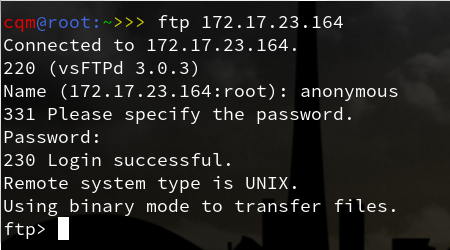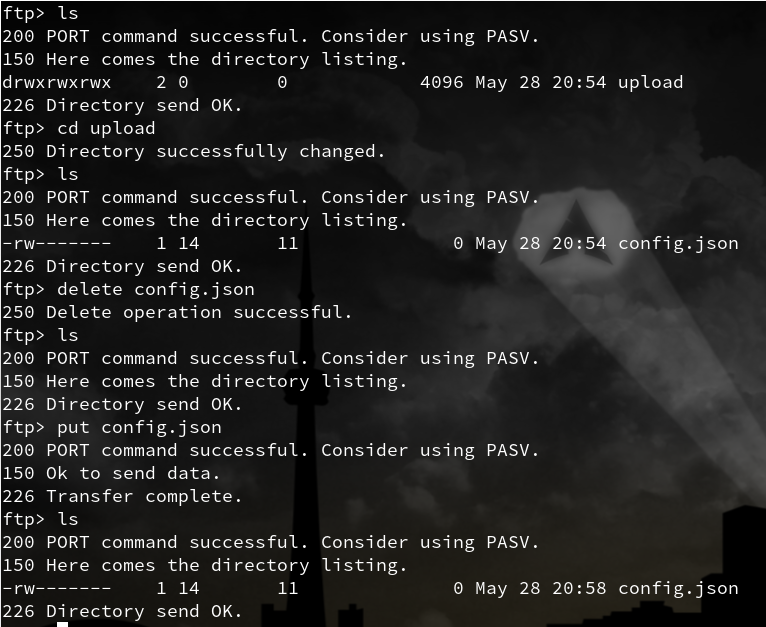Linux下ftp和ssh详解
学习了几天Linux下ftp和ssh的搭建和使用,故记录一下。学习ftp和ssh的主要目的是为了连接远程主机,并且进行文件传输。废话不多说,直接开讲!
ftp服务器
1. 环境搭建
本人的系统是Archlinux,我是基于vsftpd来搭建的,首先需要安装它: pacman -S vsftpd
接着对其配置文件进行编辑,打开/etc/vsftpd.conf(也可能在/etc/vsftdp/.vsftpd.conf)
以下是我的配置文件内容:
# Example config file /etc/vsftpd.conf
#
# The default compiled in settings are fairly paranoid. This sample file
# loosens things up a bit, to make the ftp daemon more usable.
# Please see vsftpd.conf. for all compiled in defaults.
#
# READ THIS: This example file is NOT an exhaustive list of vsftpd options.
# Please read the vsftpd.conf. manual page to get a full idea of vsftpd's
# capabilities.
#
# Allow anonymous FTP? (Beware - allowed by default if you comment this out).
anonymous_enable=YES
#
# Uncomment this to allow local users to log in.
#local_enable=YES
#
# Uncomment this to enable any form of FTP write command.
write_enable=YES
#
# Default umask for local users is . You may wish to change this to ,
# if your users expect that ( is used by most other ftpd's)
#local_umask=
#
# Uncomment this to allow the anonymous FTP user to upload files. This only
# has an effect if the above global write enable is activated. Also, you will
# obviously need to create a directory writable by the FTP user.
anon_upload_enable=YES
anon_other_write_enable=YES
#
# Uncomment this if you want the anonymous FTP user to be able to create
# new directories.
#anon_mkdir_write_enable=YES
#
# Activate directory messages - messages given to remote users when they
# go into a certain directory.
#dirmessage_enable=YES
#
# Activate logging of uploads/downloads.
#xferlog_enable=YES
#
# Make sure PORT transfer connections originate from port (ftp-data).
connect_from_port_20=YES
#
# If you want, you can arrange for uploaded anonymous files to be owned by
# a different user. Note! Using "root" for uploaded files is not
# recommended!
#chown_uploads=YES
#chown_username=whoever
#
# You may override where the log file goes if you like. The default is shown
# below.
#xferlog_file=/var/log/vsftpd.log
#
# If you want, you can have your log file in standard ftpd xferlog format.
# Note that the default log file location is /var/log/xferlog in this case.
#xferlog_std_format=YES
#
# You may change the default value for timing out an idle session.
#idle_session_timeout=
#
# You may change the default value for timing out a data connection.
#data_connection_timeout=
#
# It is recommended that you define on your system a unique user which the
# ftp server can use as a totally isolated and unprivileged user.
#nopriv_user=ftpsecure
#
# Enable this and the server will recognise asynchronous ABOR requests. Not
# recommended for security (the code is non-trivial). Not enabling it,
# however, may confuse older FTP clients.
#async_abor_enable=YES
#
# By default the server will pretend to allow ASCII mode but in fact ignore
# the request. Turn on the below options to have the server actually do ASCII
# mangling on files when in ASCII mode.
# Beware that on some FTP servers, ASCII support allows a denial of service
# attack (DoS) via the command "SIZE /big/file" in ASCII mode. vsftpd
# predicted this attack and has always been safe, reporting the size of the
# raw file.
# ASCII mangling is a horrible feature of the protocol.
#ascii_upload_enable=YES
#ascii_download_enable=YES
#
# You may fully customise the login banner string:
#ftpd_banner=Welcome to blah FTP service.
#
# You may specify a file of disallowed anonymous e-mail addresses. Apparently
# useful for combatting certain DoS attacks.
#deny_email_enable=YES
# (default follows)
#banned_email_file=/etc/vsftpd.banned_emails
#
# You may specify an explicit list of local users to chroot() to their home
# directory. If chroot_local_user is YES, then this list becomes a list of
# users to NOT chroot().
# (Warning! chroot'ing can be very dangerous. If using chroot, make sure that
# the user does not have write access to the top level directory within the
# chroot)
#chroot_local_user=YES
#chroot_list_enable=YES
# (default follows)
#chroot_list_file=/etc/vsftpd.chroot_list
#
# You may activate the "-R" option to the builtin ls. This is disabled by
# default to avoid remote users being able to cause excessive I/O on large
# sites. However, some broken FTP clients such as "ncftp" and "mirror" assume
# the presence of the "-R" option, so there is a strong case for enabling it.
#ls_recurse_enable=YES
#
# When "listen" directive is enabled, vsftpd runs in standalone mode and
# listens on IPv4 sockets. This directive cannot be used in conjunction
# with the listen_ipv6 directive.
listen=YES
#
# This directive enables listening on IPv6 sockets. To listen on IPv4 and IPv6
# sockets, you must run two copies of vsftpd with two configuration files.
# Make sure, that one of the listen options is commented !!
#listen_ipv6=YES
anon_root=/var/ftp
在以上的配置文件中,我们允许匿名用户登录,并且其有删除和上传的权限,不过这些操作仅限于在权限为777的目录下进行。我们配置匿名用户默认进入的目录为/var/ftp,此外,我们要创建一个目录upload权限为777,匿名用户可以在其中任意的操作文件。这些操作如下(本机中):
mkdir -p /var/upload
chmod /var/ftp/upload
至此,我们的环境搭建完成。
2. 使用示例
首先,配置好ftp服务器之后,需要重启,Archlinux下是
system restart vsftpd

其中,172.17.23.164是要连接的ftp服务器的IP地址
接着我们匿名登录,即用户名为anonymous,密码为空即可

这里我们用到了一些基本的命令,ls,cd等,put、get为上传/下载命令,这些百度都能轻易得知。
上图可知,我们能够在upload目录中随意操作!
ssh服务器
1. 环境搭配
安装openssh,Archlinux下直接:
pacman -S openssh
它的配置文件为/etc/ssh/sshd_config,配置后如下:
# $OpenBSD: sshd_config,v 1.101 // :: djm Exp $ # This is the sshd server system-wide configuration file. See
# sshd_config() for more information. # This sshd was compiled with PATH=/usr/bin:/bin:/usr/sbin:/sbin # The strategy used for options in the default sshd_config shipped with
# OpenSSH is to specify options with their default value where
# possible, but leave them commented. Uncommented options override the
# default value. Port
#AddressFamily any
#ListenAddress 0.0.0.0
#ListenAddress :: #HostKey /etc/ssh/ssh_host_rsa_key
#HostKey /etc/ssh/ssh_host_dsa_key
#HostKey /etc/ssh/ssh_host_ecdsa_key
#HostKey /etc/ssh/ssh_host_ed25519_key # Ciphers and keying
#RekeyLimit default none # Logging
#SyslogFacility AUTH
#LogLevel INFO # Authentication: #LoginGraceTime 2m
PermitRootLogin prohibit-password
#StrictModes yes
#MaxAuthTries
#MaxSessions #PubkeyAuthentication yes # The default is to check both .ssh/authorized_keys and .ssh/authorized_keys2
# but this is overridden so installations will only check .ssh/authorized_keys
AuthorizedKeysFile .ssh/authorized_keys #AuthorizedPrincipalsFile none #AuthorizedKeysCommand none
#AuthorizedKeysCommandUser nobody # For this to work you will also need host keys in /etc/ssh/ssh_known_hosts
#HostbasedAuthentication no
# Change to yes if you don't trust ~/.ssh/known_hosts for
# HostbasedAuthentication
#IgnoreUserKnownHosts no
# Don't read the user's ~/.rhosts and ~/.shosts files
#IgnoreRhosts yes # To disable tunneled clear text passwords, change to no here!
#PasswordAuthentication yes
#PermitEmptyPasswords no # Change to no to disable s/key passwords
ChallengeResponseAuthentication no # Kerberos options
#KerberosAuthentication no
#KerberosOrLocalPasswd yes
#KerberosTicketCleanup yes
#KerberosGetAFSToken no # GSSAPI options
#GSSAPIAuthentication no
#GSSAPICleanupCredentials yes # Set this to 'yes' to enable PAM authentication, account processing,
# and session processing. If this is enabled, PAM authentication will
# be allowed through the ChallengeResponseAuthentication and
# PasswordAuthentication. Depending on your PAM configuration,
# PAM authentication via ChallengeResponseAuthentication may bypass
# the setting of "PermitRootLogin without-password".
# If you just want the PAM account and session checks to run without
# PAM authentication, then enable this but set PasswordAuthentication
# and ChallengeResponseAuthentication to 'no'.
UsePAM yes #AllowAgentForwarding yes
#AllowTcpForwarding yes
#GatewayPorts no
#X11Forwarding no
#X11DisplayOffset
#X11UseLocalhost yes
#PermitTTY yes
PrintMotd no # pam does that
#PrintLastLog yes
#TCPKeepAlive yes
#UseLogin no
#PermitUserEnvironment no
#Compression delayed
#ClientAliveInterval
#ClientAliveCountMax
#UseDNS no
#PidFile /run/sshd.pid
#MaxStartups ::
#PermitTunnel no
#ChrootDirectory none
#VersionAddendum none # no default banner path
#Banner none # override default of no subsystems
Subsystem sftp /usr/lib/ssh/sftp-server # Example of overriding settings on a per-user basis
#Match User anoncvs
# X11Forwarding no
# AllowTcpForwarding no
# PermitTTY no
# ForceCommand cvs server
这里需要注意的是:
1. 打开port端口,将Port 22注释去除
2. 设置允许以root登录,将PermitRootLogin prohibit-password的注释去除
至此,最简单的配置完成了!
2. 密钥
一般而言,如果知道远程服务器的ip地址(假设是1.1.1.1)以及其某个用户(假设是root)的密码为000000,则可以直接:
ssh root@1.1.1.1
接着根据提示输入密码即可
但是每次都要输入密码未免太烦,于是可以采用ssh密钥机制
将ssh密钥理解为指纹,客户端的指纹在服务器端留下备份,访问的时候服务器查看客户端指纹,发现存在列表中,就可以免去登录了。
要做到这些,首先需要生成客户端自己的指纹:
ssh-keygen -t rsa
一路回车,会看到在.ssh目录下生成了密钥id_rsa和公钥id_rsa.pub,接着需要将公钥上传至服务器主机.ssh下authorized_keys中即可
一种做法是:
scp .ssh/id_rsa.pub root@1.1.1.1:/root/
这个命令将公钥上传到了服务器的/root目录下,接着进入服务器(输密码):
echo id_rsa.pub >> .ssh/authorized_keys
Linux下ftp和ssh详解的更多相关文章
- Linux下的文件目录结构详解
Linux下的文件目录结构详解 / Linux文件系统的上层根目录 /bin 存放用户可执行的程序 /boot 操作系统启动时所需要的文件 /dev 接口设备文件目录,例如:had表示硬盘 /etc ...
- Linux下DNS服务器搭建详解
Linux下DNS服务器搭建详解 DNS 即Domain Name System(域名系统)的缩写,它是一种将ip地址转换成对应的主机名或将主机名转换成与之相对应ip地址的一种机制.其中通过域名解析 ...
- Linux下tomcat的安装详解
Linux下tomcat的安装详解 来源: ChinaUnix博客 日期: 2007.01.21 22:59 (共有0条评论) 我要评论 一,安装前的准备:1,Linux版本:我的是企业版.(至于红帽 ...
- Linux下find命令用法详解
Linux下find命令用法详解 学神VIP烟火 学神IT教育:XueGod-IT 最负责任的线上直播教育平台 本文作者为VIP学员 烟火 第一部分:根据文件名查找 1.在当前目录 ...
- linux下sort命令使用详解---linux将文本文件内容加以排序命令
转载自:http://www.cnblogs.com/hitwtx/archive/2011/12/03/2274592.html linux下sort命令使用详解---linux将文本文件内容加以排 ...
- linux下getsockopt和setsockopt详解及测试
linux下getsockopt和setsockopt详解及测试 NAME 名字 getsockopt, setsockopt - get and set options on sockets 获取或 ...
- Linux下面的yum命令详解
yum(全称为 Yellow dog Updater, Modified)是一个在Fedora和RedHat以及SUSE中的Shell前端软件包管理器.基於RPM包管理,能够从指定的服务器自动下载RP ...
- Linux下usb设备驱动详解
USB驱动分为两块,一块是USB的bus驱动,这个东西,Linux内核已经做好了,我们可以不管,我们只需要了解它的功能.形象的说,USB的bus驱动相当于铺出一条路来,让所有的信息都可以通过这条USB ...
- linux下的tar命令详解
通过SSH访问服务器,难免会要用到压缩,解压缩,打包,解包等,这时候tar命令就是是必不可少的一个功能强大的工具.linux中最流行的tar是麻雀虽小,五脏俱全,功能强大. tar命令可以为linux ...
随机推荐
- 你该怎么选Offer
原文出处:http://www.360doc.com/content/15/1223/07/1209677_522436084.shtml 记录目的:自勉.分享 摘要 一段时间无数公司.无数投资人蜂拥 ...
- yyb要填的各种总结的坑
已经写好啦的 莫比乌斯反演 杜教筛 动态点分治 斜率优化 Splay 莫队 凸包 旋转卡壳 Manacher算法 Trie树 AC自动机 高斯消元 KMP算法 SA后缀数组 SAM后缀自动机 回文树 ...
- P2500 - 【DP合集】背包 bound
题面 Description N 种物品,第 i 种物品有 s i 个,单个重量为 w i ,单个价值为 v i .现有一个限重为 W 的背包,求能容 纳的物品的最大总价值. Input 输入第一行二 ...
- BZOJ第1页养成计划
嗯,用这篇博客当一个目录,方便自己和学弟(妹?)们查阅.不定期更新. BZOJ1000 BZOJ1001 BZOJ1002 BZOJ1003 BZOJ1004 BZOJ1005 ...
- 一个题目涉及到的50个Sql语句
原博客地址 http://blog.csdn.net/maco_wang/article/details/6281484 Student(S#,Sname,Sage,Ssex) 学生表 Course( ...
- Myeclipse插件快速生成ssh项目并配置注解 在action层注入service的超详细过程
最近发现,我对于ssh的 自动注入配置 还是不熟悉,于是整理了一下 终于做了一个 简单的 注入配置出来. 以前都是在applicationContext.xml 里面这样配 <bean id=& ...
- 小程序 for循环 报错 Cannot read property 'total' of undefined
for循环一直报错 Cannot read property 'total' of undefined,但total在起初是有定义的,后来找到了问题,是i<=的问题,改为<不报错了. i ...
- 我的C++学习之旅
说在前面:1.学习缘由及学习途径: 在学了Python,c#(自认为未精通)之后,我决定学一下C++. 于是去网上找视频教程,发现都不适合我这种有一定基础的自学者,要么是不完整的高级教程,要么是零基础 ...
- WPF自学入门(九)WPF自定义窗口基类
今天简单记录一个知识点:WPF自定义窗口基类,常用winform的人知道,winform的窗体继承是很好用的,写一个基础窗体,直接在后台代码改写继承窗体名.但如果是WPF要继承窗体,我个人感觉没有理解 ...
- IE 兼容 getElementsByClassName
getElementsByClassName 通过class获取节点,是很多新人练习原生JS都用到的,项目中也会写,当项目进行到一定程度时,测试IE低版本,忽然发现不支持的时候,瞬间感觉整个人都不好了 ...
